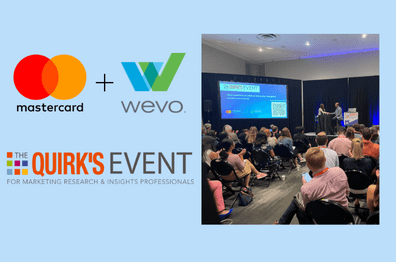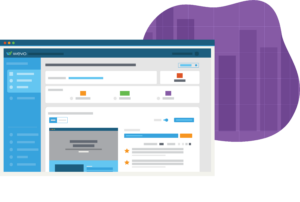Contents
The Quirk’s Event is one of the largest events in the market research industry. In July, WEVO made its Quirk’s Event debut in New York when CEO Nitzan Shaer and Mastercard SVP Customer Experience & Design Cindy Chastain held a fireside chat without an actual fire (with Manhattan’s summer temps in the 90s, that was probably for the best). But they nonetheless brought the burning insights to a standing-room crowd to hear how Mastercard will use WEVO to test all of its digital experiences before they launch.
More than an iconic logo in your wallet
“People think we’re just a credit card company. We’re actually a technology company in the payments industry, and also focused on innovation in areas such as digital identity,” says Cindy Chastain, Senior Vice President of Customer Experience and Design. And with more than 435 products already, successful ideas clearly fuel Mastercard.
“Saying you’re a customer-focused company has become as expected as ‘motherhood and apple pie,’” Cindy says. So Mastercard must go beyond: continuously innovating quickly, at scale, and with more certainty, to deliver outstanding experiences that their customers–banks and financial institutions– find valuable (Mastercard does not sell directly to consumers).
Much of this innovation comes out of Mastercard’s innovation arm, the Foundry, dedicated to expanding commerce through new product investigation, research and development. There, Cindy leads a multi-disciplinary team of customer experience, product and engineering, charged with second- and third-horizon innovations that come from emerging technologies such as quantum computing, the metaverse and Web3.
“Even though we’re B2B2C, we work like we’re B2C,” Cindy says. And when development projects can be multi-million dollar decisions, based on the anecdotal input of 10 customers, Mastercard must be especially strategic, purposeful, and swift in determining which new products and services to develop.
De-risking to increase success
Given the financial stakes and regulatory hurdles, using traditional anecdotal research of five to 10 customers to influence the future of potential multimillion-, or multi-billion-dollar, products is a huge risk.
“Our main challenge is ensuring that we’re helping the organization de-risk everything we’re putting out in the world. How do you do that? Research into creating quality that will drive adoption and use,” Cindy said. “Otherwise we’re not going to be successful and our customers won’t be either.”
Their ambitious mandate required an equally ambitious strategy: to test every single digital concept or experience before it goes live. To do that, Mastercard and Cindy needed a platform that would:
- Deliver reliable, not anecdotal, results
- Be effortless to use by anyone: UX researchers, marketers, designers and product managers
- De-risk every new product or service it develops
The WEVO advantage
Mastercard selected WEVO as their primary user research platform because WEVO’s AI made it easier for Mastercard to test experiences earlier in the process and to identify winning designs with more certainty. Those products and concepts that achieve a certain minimum score proceed in development. Those that do not reach that minimum will go back to be redesigned, or could be scrapped entirely.
Now, Mastercard can reliably score every experience, prototype or concept with:
- Faster time to run studies, requiring only 30 minutes of a researcher’s active time, instead of the usual 50+ hours of panel recruitment, study execution, video editing and findings reporting
- Summarized key findings that all job functions can understand
- More reliable results, based on a sample size of 120-300
- Diagnostics that break down how clear and appealing the proposed experience is
- Visual analysis showing areas that attracted people and helped them move forward, and areas that they found confusing or disliked
So far, Mastercard’s been very happy with the results. “WEVO’s been such a great partner to us. We needed a platform that would enable us to innovate at scale. WEVO helps us de-risk concepts and increase the likelihood of their use and adoption once developed,” Cindy said.
Getting deep into how Mastercard innovates
The Quirk’s audience paid close attention to Mastercard’s basic innovation framework to de-risk (which WEVO fits well into!):
- Validating concepts, designs, journeys and prototypes
- Measuring the quality of the end-to-end design to be inclusive of research and user experience
- Ensuring that best practices inform every stage of the process
- Creating those high quality customer experiences
- Preventing biased results
Mastercard has more runway to find that next big service or idea, because WEVO also helps employees develop their research skills—an area of employee development that Mastercard has internally identified as an enterprise-wide need.
De-risk . . . and democratize
If that skills development sounds like an argument in favor of democratizing insights, Cindy advised the audience that the key is to provide the guardrails for studies to be done reliably.
She pointed out that many companies already have research being done in multiple places: market research to investigate if a new market of a certain size is worth pursuing, and UX research to focus on developing helpful well-designed products that solve problems.
“Research should be participatory. It should not just be that smart people go away, do a study, share the output and then decide to apply it. Product and engineering teams should be involved, like in watching studies,” she said. “We have everyone do friends and family interviews in the early stages. It’s something that we’ve codified so teams will make better decisions together.”
“We’re not going to bring in 500 new user researchers tomorrow,” she added. “In order for us to scale, we need to grow skills in different places. I’m able to get product people to use WEVO to conduct research responsibly, not anecdotally.”
But, Cindy cautioned, “you have to be very intentional. It’s not a free-for-all for everyone. Our framework talks about what types of research one might do at every stage. There are some very specific things you have to leave to professionals. Other things are easier to let other people do when supported by a platform like WEVO, by training, and by best practices. So we clearly communicate that and then enable it.”
What can other companies learn from this?
The Quirk’s Event format limits presentations to only 30 minutes–and there was so much more the audience wanted to discuss. Cindy and Nitzan closed on one final and vital question: How can companies of any size do more user research, reliably with their existing level of resources?
Cindy’s advice: Measure success. Show proof points. Connect it to revenue “and show that it can’t be done alone, but with cross-functional partners. Because everybody needs to come to the table.” It helps to make the process easy for people to participate. “I’m really passionate about ethnographic research, and going out into the field. I bring engineers and product people along. And suddenly, they see things from the lens of what you do,” she said.



